Yubo Ma
Towards Storage-Efficient Visual Document Retrieval: An Empirical Study on Reducing Patch-Level Embeddings
Jun 05, 2025Abstract:Despite the strong performance of ColPali/ColQwen2 in Visualized Document Retrieval (VDR), it encodes each page into multiple patch-level embeddings and leads to excessive memory usage. This empirical study investigates methods to reduce patch embeddings per page at minimum performance degradation. We evaluate two token-reduction strategies: token pruning and token merging. Regarding token pruning, we surprisingly observe that a simple random strategy outperforms other sophisticated pruning methods, though still far from satisfactory. Further analysis reveals that pruning is inherently unsuitable for VDR as it requires removing certain page embeddings without query-specific information. Turning to token merging (more suitable for VDR), we search for the optimal combinations of merging strategy across three dimensions and develop Light-ColPali/ColQwen2. It maintains 98.2% of retrieval performance with only 11.8% of original memory usage, and preserves 94.6% effectiveness at 2.8% memory footprint. We expect our empirical findings and resulting Light-ColPali/ColQwen2 offer valuable insights and establish a competitive baseline for future research towards efficient VDR.
MTR-Bench: A Comprehensive Benchmark for Multi-Turn Reasoning Evaluation
May 26, 2025Abstract:Recent advances in Large Language Models (LLMs) have shown promising results in complex reasoning tasks. However, current evaluations predominantly focus on single-turn reasoning scenarios, leaving interactive tasks largely unexplored. We attribute it to the absence of comprehensive datasets and scalable automatic evaluation protocols. To fill these gaps, we present MTR-Bench for LLMs' Multi-Turn Reasoning evaluation. Comprising 4 classes, 40 tasks, and 3600 instances, MTR-Bench covers diverse reasoning capabilities, fine-grained difficulty granularity, and necessitates multi-turn interactions with the environments. Moreover, MTR-Bench features fully-automated framework spanning both dataset constructions and model evaluations, which enables scalable assessment without human interventions. Extensive experiments reveal that even the cutting-edge reasoning models fall short of multi-turn, interactive reasoning tasks. And the further analysis upon these results brings valuable insights for future research in interactive AI systems.
Toward Generalizable Evaluation in the LLM Era: A Survey Beyond Benchmarks
Apr 26, 2025Abstract:Large Language Models (LLMs) are advancing at an amazing speed and have become indispensable across academia, industry, and daily applications. To keep pace with the status quo, this survey probes the core challenges that the rise of LLMs poses for evaluation. We identify and analyze two pivotal transitions: (i) from task-specific to capability-based evaluation, which reorganizes benchmarks around core competencies such as knowledge, reasoning, instruction following, multi-modal understanding, and safety; and (ii) from manual to automated evaluation, encompassing dynamic dataset curation and "LLM-as-a-judge" scoring. Yet, even with these transitions, a crucial obstacle persists: the evaluation generalization issue. Bounded test sets cannot scale alongside models whose abilities grow seemingly without limit. We will dissect this issue, along with the core challenges of the above two transitions, from the perspectives of methods, datasets, evaluators, and metrics. Due to the fast evolving of this field, we will maintain a living GitHub repository (links are in each section) to crowd-source updates and corrections, and warmly invite contributors and collaborators.
Synergistic Weak-Strong Collaboration by Aligning Preferences
Apr 22, 2025Abstract:Current Large Language Models (LLMs) excel in general reasoning yet struggle with specialized tasks requiring proprietary or domain-specific knowledge. Fine-tuning large models for every niche application is often infeasible due to black-box constraints and high computational overhead. To address this, we propose a collaborative framework that pairs a specialized weak model with a general strong model. The weak model, tailored to specific domains, produces initial drafts and background information, while the strong model leverages its advanced reasoning to refine these drafts, extending LLMs' capabilities to critical yet specialized tasks. To optimize this collaboration, we introduce a collaborative feedback to fine-tunes the weak model, which quantifies the influence of the weak model's contributions in the collaboration procedure and establishes preference pairs to guide preference tuning of the weak model. We validate our framework through experiments on three domains. We find that the collaboration significantly outperforms each model alone by leveraging complementary strengths. Moreover, aligning the weak model with the collaborative preference further enhances overall performance.
InternLM-XComposer2.5-Reward: A Simple Yet Effective Multi-Modal Reward Model
Jan 21, 2025



Abstract:Despite the promising performance of Large Vision Language Models (LVLMs) in visual understanding, they occasionally generate incorrect outputs. While reward models (RMs) with reinforcement learning or test-time scaling offer the potential for improving generation quality, a critical gap remains: publicly available multi-modal RMs for LVLMs are scarce, and the implementation details of proprietary models are often unclear. We bridge this gap with InternLM-XComposer2.5-Reward (IXC-2.5-Reward), a simple yet effective multi-modal reward model that aligns LVLMs with human preferences. To ensure the robustness and versatility of IXC-2.5-Reward, we set up a high-quality multi-modal preference corpus spanning text, image, and video inputs across diverse domains, such as instruction following, general understanding, text-rich documents, mathematical reasoning, and video understanding. IXC-2.5-Reward achieves excellent results on the latest multi-modal reward model benchmark and shows competitive performance on text-only reward model benchmarks. We further demonstrate three key applications of IXC-2.5-Reward: (1) Providing a supervisory signal for RL training. We integrate IXC-2.5-Reward with Proximal Policy Optimization (PPO) yields IXC-2.5-Chat, which shows consistent improvements in instruction following and multi-modal open-ended dialogue; (2) Selecting the best response from candidate responses for test-time scaling; and (3) Filtering outlier or noisy samples from existing image and video instruction tuning training data. To ensure reproducibility and facilitate further research, we have open-sourced all model weights and training recipes at https://github.com/InternLM/InternLM-XComposer
Long Context vs. RAG for LLMs: An Evaluation and Revisits
Dec 27, 2024
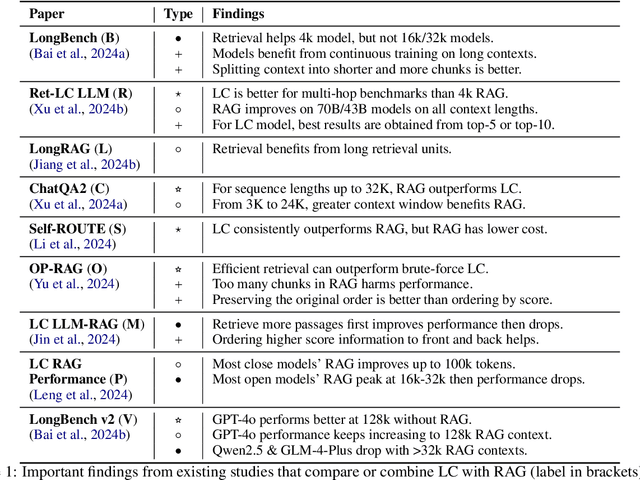
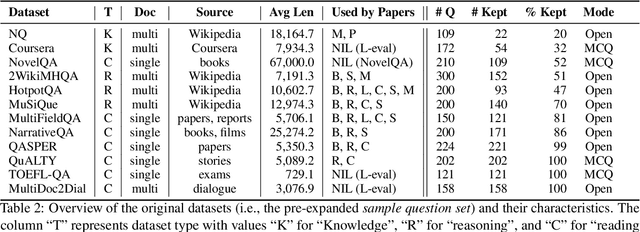
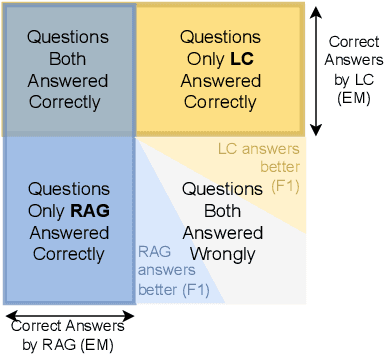
Abstract:Extending context windows (i.e., Long Context, LC) and using retrievers to selectively access relevant information (i.e., Retrieval-Augmented Generation, RAG) are the two main strategies to enable LLMs to incorporate extremely long external contexts. This paper revisits recent studies on this topic, highlighting their key insights and discrepancies. We then provide a more comprehensive evaluation by filtering out questions answerable without external context, identifying the most effective retrieval methods, and expanding the datasets. We show that LC generally outperforms RAG in question-answering benchmarks, especially for Wikipedia-based questions. Summarization-based retrieval performs comparably to LC, while chunk-based retrieval lags behind. However, RAG has advantages in dialogue-based and general question queries. These insights underscore the trade-offs between RAG and LC strategies, offering guidance for future optimization of LLMs with external knowledge sources. We also provide an in-depth discussion on this topic, highlighting the overlooked importance of context relevance in existing studies.
AntiLeak-Bench: Preventing Data Contamination by Automatically Constructing Benchmarks with Updated Real-World Knowledge
Dec 18, 2024



Abstract:Data contamination hinders fair LLM evaluation by introducing test data into newer models' training sets. Existing studies solve this challenge by updating benchmarks with newly collected data. However, they fail to guarantee contamination-free evaluation as the newly collected data may contain pre-existing knowledge, and their benchmark updates rely on intensive human labor. To address these issues, we in this paper propose AntiLeak-Bench, an automated anti-leakage benchmarking framework. Instead of simply using newly collected data, we construct samples with explicitly new knowledge absent from LLMs' training sets, which thus ensures strictly contamination-free evaluation. We further design a fully automated workflow to build and update our benchmark without human labor. This significantly reduces the cost of benchmark maintenance to accommodate emerging LLMs. Through extensive experiments, we highlight that data contamination likely exists before LLMs' cutoff time and demonstrate AntiLeak-Bench effectively overcomes this challenge.
Navigating the Nuances: A Fine-grained Evaluation of Vision-Language Navigation
Sep 25, 2024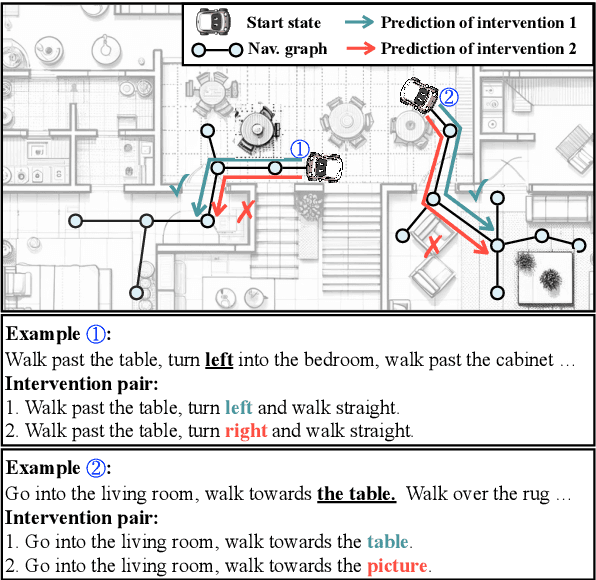


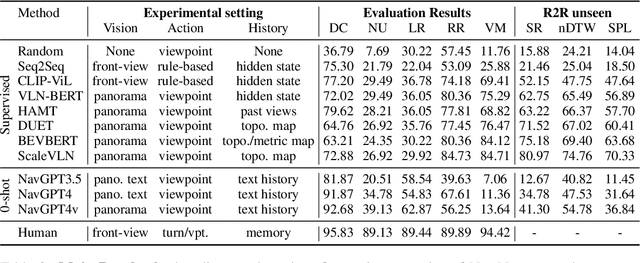
Abstract:This study presents a novel evaluation framework for the Vision-Language Navigation (VLN) task. It aims to diagnose current models for various instruction categories at a finer-grained level. The framework is structured around the context-free grammar (CFG) of the task. The CFG serves as the basis for the problem decomposition and the core premise of the instruction categories design. We propose a semi-automatic method for CFG construction with the help of Large-Language Models (LLMs). Then, we induct and generate data spanning five principal instruction categories (i.e. direction change, landmark recognition, region recognition, vertical movement, and numerical comprehension). Our analysis of different models reveals notable performance discrepancies and recurrent issues. The stagnation of numerical comprehension, heavy selective biases over directional concepts, and other interesting findings contribute to the development of future language-guided navigation systems.
TART: An Open-Source Tool-Augmented Framework for Explainable Table-based Reasoning
Sep 18, 2024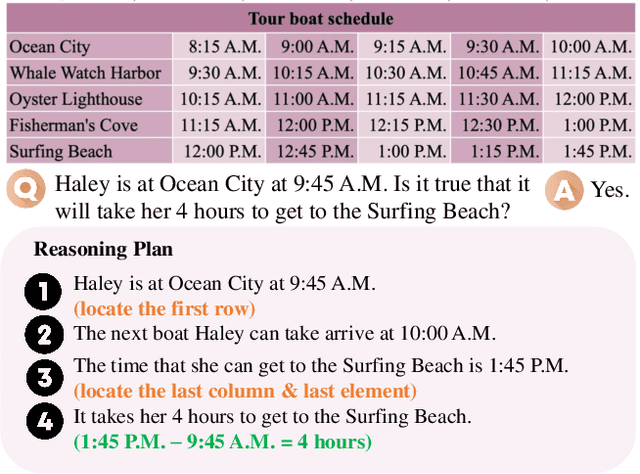
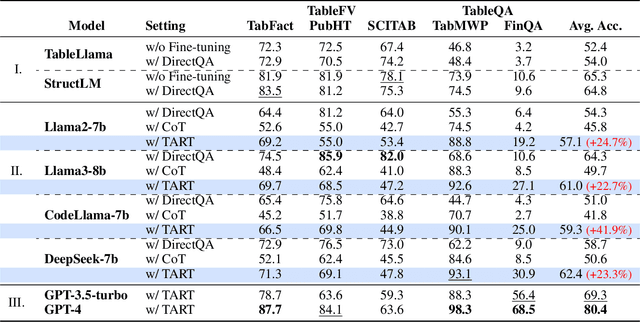
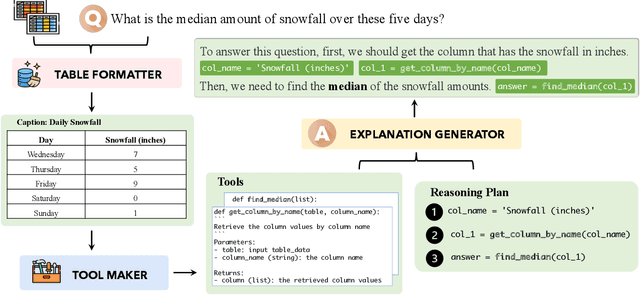
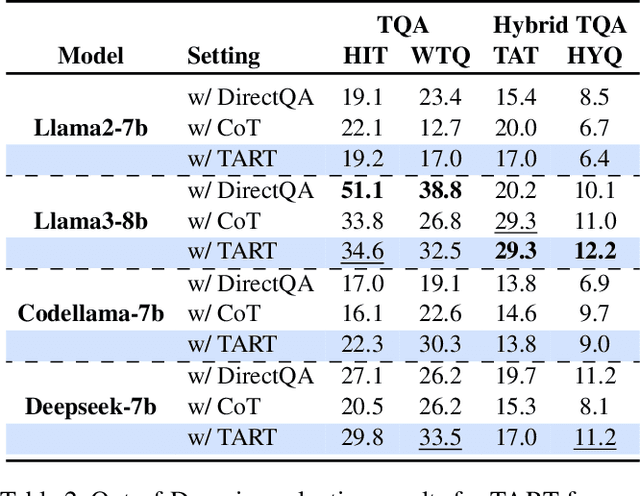
Abstract:Current Large Language Models (LLMs) exhibit limited ability to understand table structures and to apply precise numerical reasoning, which is crucial for tasks such as table question answering (TQA) and table-based fact verification (TFV). To address these challenges, we introduce our Tool-Augmented Reasoning framework for Tables (TART), which integrates LLMs with specialized tools. TART contains three key components: a table formatter to ensure accurate data representation, a tool maker to develop specific computational tools, and an explanation generator to maintain explainability. We also present the TOOLTAB dataset, a new benchmark designed specifically for training LLMs in table-tool integration. Our experiments indicate that TART achieves substantial improvements over existing methods (e.g., Chain-of-Thought) by improving both the precision of data processing and the clarity of the reasoning process. Notably, TART paired with CodeLlama achieves 90.0% of the accuracy of the closed-sourced LLM GPT-3.5-turbo, highlighting its robustness in diverse real-world scenarios. All the code and data are available at https://github.com/XinyuanLu00/TART.
MMLongBench-Doc: Benchmarking Long-context Document Understanding with Visualizations
Jul 01, 2024Abstract:Understanding documents with rich layouts and multi-modal components is a long-standing and practical task. Recent Large Vision-Language Models (LVLMs) have made remarkable strides in various tasks, particularly in single-page document understanding (DU). However, their abilities on long-context DU remain an open problem. This work presents MMLongBench-Doc, a long-context, multi-modal benchmark comprising 1,062 expert-annotated questions. Distinct from previous datasets, it is constructed upon 130 lengthy PDF-formatted documents with an average of 49.4 pages and 20,971 textual tokens. Towards comprehensive evaluation, answers to these questions rely on pieces of evidence from (1) different sources (text, image, chart, table, and layout structure) and (2) various locations (i.e. page number). Moreover, 33.2% of the questions are cross-page questions requiring evidence across multiple pages. 22.8% of the questions are designed to be unanswerable for detecting potential hallucinations. Experiments on 14 LVLMs demonstrate that long-context DU greatly challenges current models. Notably, the best-performing model, GPT-4o, achieves an F1 score of only 42.7%, while the second-best, GPT-4V, scores 31.4%. Furthermore, 12 LVLMs (all except GPT-4o and GPT-4V) even present worse performance than their LLM counterparts which are fed with lossy-parsed OCR documents. These results validate the necessity of future research toward more capable long-context LVLMs. Project Page: https://mayubo2333.github.io/MMLongBench-Doc
 Add to Chrome
Add to Chrome Add to Firefox
Add to Firefox Add to Edge
Add to Edge